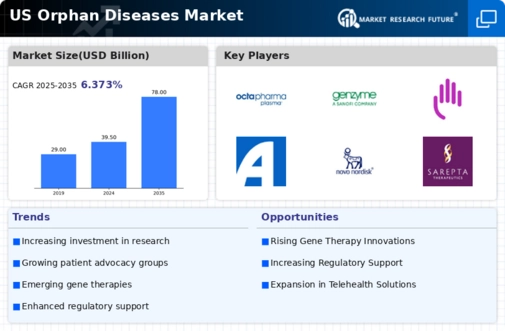US Orphan Diseases Market Summary
The US Orphan Diseases market is projected to grow significantly, reaching 78 USD Billion by 2035 from a base of 39.5 USD Billion in 2024.
Key Market Trends & Highlights
US Orphan Diseases Key Trends and Highlights
- The US Orphan Diseases market is valued at 39.5 USD Billion in 2024.
- By 2035, the market is expected to expand to 78 USD Billion, indicating robust growth.
- The compound annual growth rate (CAGR) for the period from 2025 to 2035 is estimated at 6.37%.
- Growing adoption of innovative therapies due to increasing prevalence of orphan diseases is a major market driver.
Market Size & Forecast
| 2024 Market Size | 39.5 (USD Billion) |
| 2035 Market Size | 78 (USD Billion) |
| CAGR (2025-2035) | 6.37% |
Major Players
Octapharma, Genzyme, Bristol Myers Squibb, Takeda Pharmaceutical, Regeneron Pharmaceuticals, Horizon Therapeutics, Novo Nordisk, Sarepta Therapeutics, Eisai, Alexion Pharmaceuticals, Amgen, Biogen, Sanofi, Ultragenyx Pharmaceutical, Vertex Pharmaceuticals





















Leave a Comment